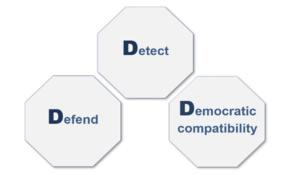Wright, N.

Part I of this report delineates the challenge for the Joint Force in our digitizing world. Part II describes a practical, effective response through a strategy centered on “3 Ds.” (1) DETECT: Build capabilities to detect and characterize influence operations against the Joint Force – who is targeted, by what means and for what purposes? (2) DEFEND: Human cognition always contains vulnerabilities, which can be minimized and so denied to others. Mass personalization of influence operations is coming; countering it requires new human-AI teams and organization. (3) DEMOCRATIC COMPATIBILITY: Make new capabilities compatible with a free society, whilst also mitigating the gaps this entails – a challenge that speaks directly to the Interim National Security Strategic Guidance (Biden, 2021). Restraint is not just a bug of the U.S. system, it is a strength.
No comments:
Post a Comment